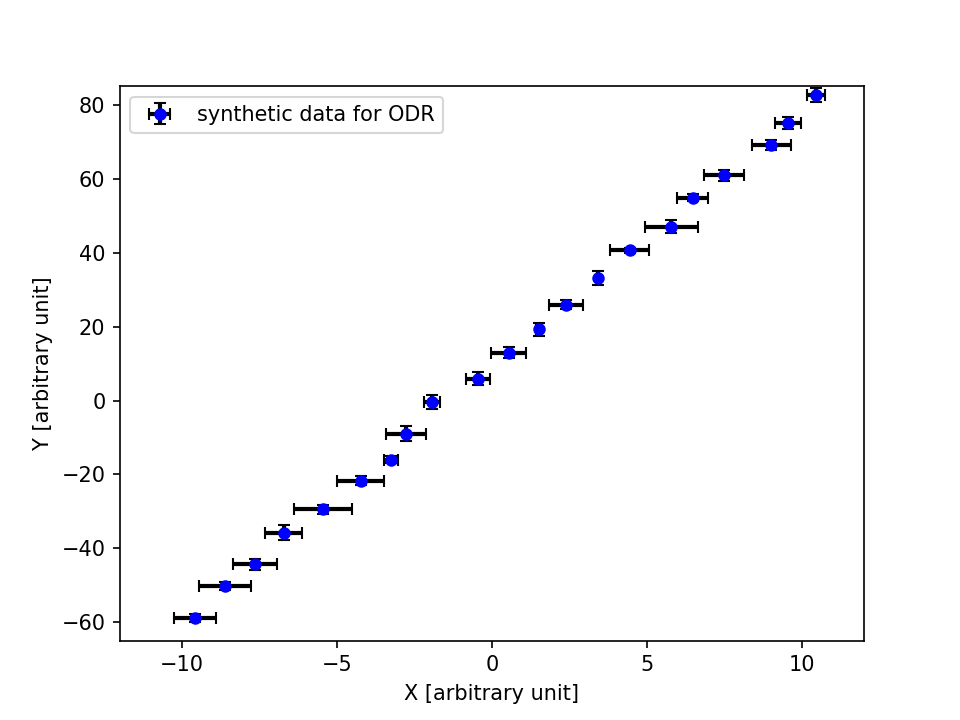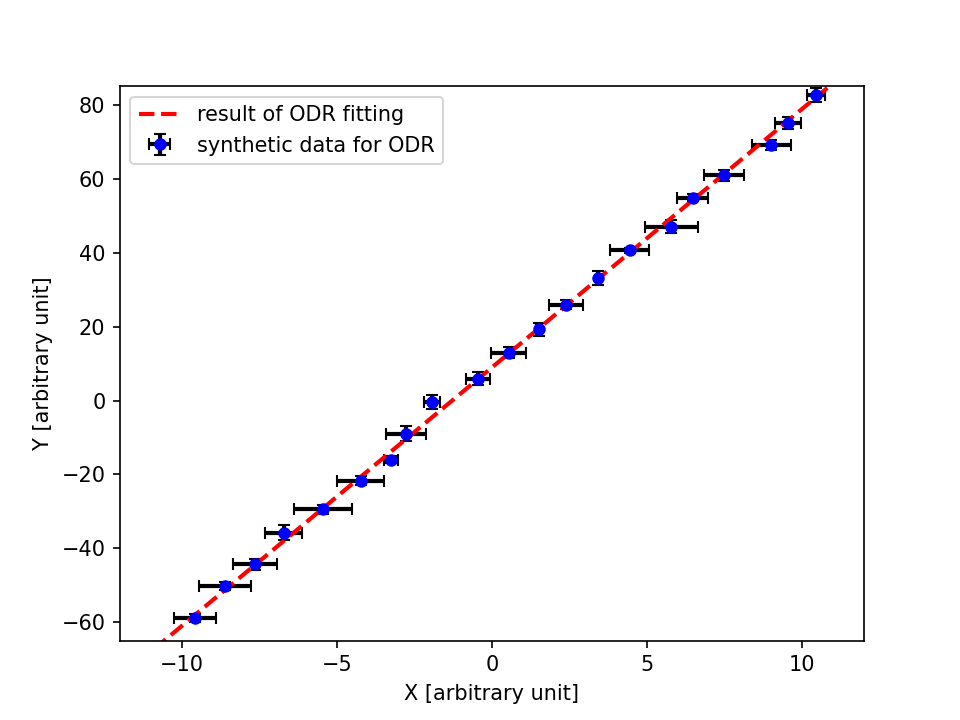
|
|---|
これは日々の作業を通して学んだことや毎日の生活で気づいたことをを記録しておく備忘録である。
HTML ファイル生成日時: 2025/12/17 11:43:53.312 (台灣標準時)
Scipy に ODR (Orthogonal Distance Regression) を行ってくれるサブモジュー ルがあるようなので試してみたでござる。その方法を記録しておくでござる。
まず、データを用意するでござる。
#!/usr/pkg/bin/python3.13 # # Time-stamp: <2025/03/16 13:12:01 (UT+08:00) daisuke> # # importing numpy module import numpy # parameters a = 7.0 b = 11.0 xerr_mean = 0.5 xerr_stddev = 0.2 yerr_mean = 1.5 yerr_stddev = 0.6 x_min = -10.0 x_max = +10.0 n_data = 21 file_output = 'test_scipy_odr_00.data' # function for generating data def func (x, a, b): y = a * x + b return (y) # random number generator rng = numpy.random.default_rng () # generating synthetic data x = numpy.linspace (x_min, x_max, n_data) \ + numpy.absolute ( rng.normal (loc=xerr_mean, scale=xerr_stddev, size=n_data) ) x_err = numpy.absolute ( rng.normal (loc=xerr_mean, scale=xerr_stddev, size=n_data) ) y = func (numpy.linspace (x_min, x_max, n_data), a, b) \ + numpy.absolute ( rng.normal (loc=yerr_mean, scale=yerr_stddev, size=n_data) ) y_err = numpy.absolute ( rng.normal (loc=yerr_mean, scale=yerr_stddev, size=n_data) ) # writing generated synthetic data to a file with open (file_output, 'w') as fh_w: fh_w.write (f'#\n') fh_w.write (f'# synthetic data for fitting using ODR\n') fh_w.write (f'#\n') fh_w.write (f'# format of this data file:\n') fh_w.write (f'# 1st column : x\n') fh_w.write (f'# 2nd column : x_err\n') fh_w.write (f'# 3rd column : y\n') fh_w.write (f'# 4th column : y_err\n') fh_w.write (f'#\n') for i in range (len (x)): fh_w.write (f'{x[i]:8.3f} {x_err[i]:8.3f} {y[i]:8.3f} {y_err[i]:8.3f}\n')
このプログラムを実行してみるでござる。
% python3.13 test_scipy_odr_00.py % head -20 test_scipy_odr_00.data # # synthetic data for fitting using ODR # # format of this data file: # 1st column : x # 2nd column : x_err # 3rd column : y # 4th column : y_err # -9.583 0.678 -58.732 1.111 -8.621 0.834 -50.153 1.067 -7.650 0.720 -44.284 1.446 -6.724 0.608 -35.783 2.054 -5.439 0.934 -29.379 1.229 -4.239 0.756 -21.663 1.192 -3.256 0.227 -15.995 0.970 -2.764 0.645 -8.958 2.057 -1.942 0.267 -0.448 1.913 -0.455 0.381 5.920 1.717 0.539 0.570 12.917 1.535
作ったデータを可視化してみるでござる。
#!/usr/pkg/bin/python3.13 # # Time-stamp: <2025/03/16 13:12:07 (UT+08:00) daisuke> # # importing numpy module import numpy # importing matplotlib module import matplotlib.backends.backend_agg import matplotlib.figure # input data file name file_input = 'test_scipy_odr_00.data' # output image file name file_output = 'test_scipy_odr_01.png' # resolution in DPI resolution_dpi = 150 # making empty lists for storing data list_x = [] list_x_err = [] list_y = [] list_y_err = [] # opening data file for reading with open (file_input, 'r') as fh_r: # reading file line-by-line for line in fh_r: # skip if the line starts with '#' if (line[0] == '#'): continue # splitting data (x_str, x_err_str, y_str, y_err_str) = line.split () # converting string into float x = float (x_str) x_err = float (x_err_str) y = float (y_str) y_err = float (y_err_str) # appending data to the end of lists list_x.append (x) list_x_err.append (x_err) list_y.append (y) list_y_err.append (y_err) # making numpy arrays array_x = numpy.array (list_x) array_xerr = numpy.array (list_x_err) array_y = numpy.array (list_y) array_yerr = numpy.array (list_y_err) # making a fig object using object-oriented interface fig = matplotlib.figure.Figure () # making a canvas object canvas = matplotlib.backends.backend_agg.FigureCanvasAgg (fig) # making an axes object ax = fig.add_subplot (111) # axes ax.set_xlabel ('X [arbitrary unit]') ax.set_ylabel ('Y [arbitrary unit]') ax.set_xlim (-12.0, +12.0) ax.set_ylim (-65.0, +85.0) # plotting data ax.errorbar (array_x, array_y, xerr=array_xerr, yerr=array_yerr, \ linestyle='None', marker='o', markersize=5, color='blue', \ ecolor='black', elinewidth=2, capsize=3, \ label='synthetic data for ODR') # legend ax.legend () # saving plot into file fig.savefig (file_output, dpi=resolution_dpi)
実行してみるでござる。
% python3.13 test_scipy_odr_01.py % ls -lF *.png -rw-r--r-- 1 daisuke taiwan 34277 Mar 16 13:12 test_scipy_odr_01.png % feh -dF test_scipy_odr_01.png

|
|---|
scipy.odr を使ってフィッティングを行ってみるでござる。
#!/usr/pkg/bin/python3.13 # # Time-stamp: <2025/03/16 13:12:16 (UT+08:00) daisuke> # # importing numpy module import numpy # importing scipy module import scipy # input data file name file_input = 'test_scipy_odr_00.data' # making empty lists for storing data list_x = [] list_x_err = [] list_y = [] list_y_err = [] # opening data file for reading with open (file_input, 'r') as fh_r: # reading file line-by-line for line in fh_r: # skip if the line starts with '#' if (line[0] == '#'): continue # splitting data (x_str, x_err_str, y_str, y_err_str) = line.split () # converting string into float x = float (x_str) x_err = float (x_err_str) y = float (y_str) y_err = float (y_err_str) # appending data to the end of lists list_x.append (x) list_x_err.append (x_err) list_y.append (y) list_y_err.append (y_err) # making numpy arrays array_x = numpy.array (list_x) array_xerr = numpy.array (list_x_err) array_y = numpy.array (list_y) array_yerr = numpy.array (list_y_err) # # fitting using ODR # # initial guess of coefficients initial_guess = [1.0, 1.0] # function for fitting def func (coeff, x): y = coeff[0] * x + coeff[1] return (y) # making a model for ODR odr_model = scipy.odr.Model (func) # making data for ODR odr_data = scipy.odr.Data (array_x, array_y, \ wd=1.0/(array_xerr**2), we=1.0/(array_yerr**2)) # making ODR object for fitting odr_fitting = scipy.odr.ODR (odr_data, odr_model, beta0=initial_guess) # carrying out ODR fitting odr_result = odr_fitting.run () # printing result of ODR fitting print (odr_result.pprint ()) # printing fitted coefficients and their errors print (f'') print (f'fitted coefficients') print (f' a = {odr_result.beta[0]:8.3f} +/- {odr_result.sd_beta[0]:8.3f}') print (f' b = {odr_result.beta[1]:8.3f} +/- {odr_result.sd_beta[1]:8.3f}')
実行結果は以下の通りでござる。
% python3.13 test_scipy_odr_02.py Beta: [6.9908854 8.9742435] Beta Std Error: [0.07232446 0.37805593] Beta Covariance: [[ 0.02006738 -0.02606751] [-0.02606751 0.54831792]] Residual Variance: 0.2606631741946989 Inverse Condition #: 0.20187026330190005 Reason(s) for Halting: Sum of squares convergence None fitted coefficients a = 6.991 +/- 0.072 b = 8.974 +/- 0.378
フィッティングの結果を可視化してみるでござる。
#!/usr/pkg/bin/python3.13 # # Time-stamp: <2025/03/16 13:12:22 (UT+08:00) daisuke> # # importing numpy module import numpy # importing scipy module import scipy # importing matplotlib module import matplotlib.backends.backend_agg import matplotlib.figure # input data file name file_input = 'test_scipy_odr_00.data' # output image file name file_output = 'test_scipy_odr_03.png' # resolution in DPI resolution_dpi = 150 # parameters x_min = -12.0 x_max = +12.0 # making empty lists for storing data list_x = [] list_x_err = [] list_y = [] list_y_err = [] # opening data file for reading with open (file_input, 'r') as fh_r: # reading file line-by-line for line in fh_r: # skip if the line starts with '#' if (line[0] == '#'): continue # splitting data (x_str, x_err_str, y_str, y_err_str) = line.split () # converting string into float x = float (x_str) x_err = float (x_err_str) y = float (y_str) y_err = float (y_err_str) # appending data to the end of lists list_x.append (x) list_x_err.append (x_err) list_y.append (y) list_y_err.append (y_err) # making numpy arrays array_x = numpy.array (list_x) array_xerr = numpy.array (list_x_err) array_y = numpy.array (list_y) array_yerr = numpy.array (list_y_err) # # fitting using ODR # # initial guess of coefficients initial_guess = [1.0, 1.0] # function for fitting def func (coeff, x): y = coeff[0] * x + coeff[1] return (y) # making a model for ODR odr_model = scipy.odr.Model (func) # making data for ODR odr_data = scipy.odr.Data (array_x, array_y, \ wd=1.0/(array_xerr**2), we=1.0/(array_yerr**2)) # making ODR object for fitting odr_fitting = scipy.odr.ODR (odr_data, odr_model, beta0=initial_guess) # carrying out ODR fitting odr_result = odr_fitting.run () # printing result of ODR fitting print (odr_result.pprint ()) # printing fitted coefficients and their errors print (f'') print (f'fitted coefficients') print (f' a = {odr_result.beta[0]:8.3f} +/- {odr_result.sd_beta[0]:8.3f}') print (f' b = {odr_result.beta[1]:8.3f} +/- {odr_result.sd_beta[1]:8.3f}') # making a fig object using object-oriented interface fig = matplotlib.figure.Figure () # making a canvas object canvas = matplotlib.backends.backend_agg.FigureCanvasAgg (fig) # making an axes object ax = fig.add_subplot (111) # axes ax.set_xlabel ('X [arbitrary unit]') ax.set_ylabel ('Y [arbitrary unit]') ax.set_xlim (-12.0, +12.0) ax.set_ylim (-65.0, +85.0) # plotting data ax.errorbar (array_x, array_y, xerr=array_xerr, yerr=array_yerr, \ linestyle='None', marker='o', markersize=5, color='blue', \ ecolor='black', elinewidth=2, capsize=3, \ label='synthetic data for ODR') # plotting fitted line array_x_fitted = numpy.linspace (x_min, x_max, 10000) array_y_fitted = func ((odr_result.beta[0], odr_result.beta[1]), array_x_fitted) ax.plot (array_x_fitted, array_y_fitted, \ linestyle='--', linewidth=2, color='red', \ label='result of ODR fitting') # legend ax.legend () # saving plot into file fig.savefig (file_output, dpi=resolution_dpi)
実行してみた結果は、以下の通りでござる。
% python3.13 test_scipy_odr_03.py Beta: [6.9908854 8.9742435] Beta Std Error: [0.07232446 0.37805593] Beta Covariance: [[ 0.02006738 -0.02606751] [-0.02606751 0.54831792]] Residual Variance: 0.2606631741946989 Inverse Condition #: 0.20187026330190005 Reason(s) for Halting: Sum of squares convergence None fitted coefficients a = 6.991 +/- 0.072 b = 8.974 +/- 0.378 % ls -lF *.png -rw-r--r-- 1 daisuke taiwan 34277 Mar 16 13:12 test_scipy_odr_01.png -rw-r--r-- 1 daisuke taiwan 45490 Mar 16 13:16 test_scipy_odr_03.png % feh -dF test_scipy_odr_03.png

|
|---|